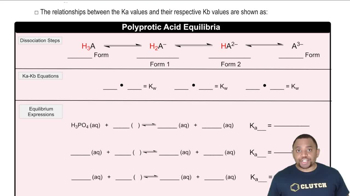Here are the essential concepts you must grasp in order to answer the question correctly.
Henderson-Hasselbalch Equation
The Henderson-Hasselbalch equation is a mathematical formula used to calculate the pH of a buffer solution. It is expressed as pH = pKa + log([A-]/[HA]), where pKa is the negative logarithm of the acid dissociation constant (Ka) of the weak acid, [A-] is the concentration of the conjugate base, and [HA] is the concentration of the weak acid. This equation highlights the relationship between the pH of a solution and the ratio of the concentrations of the acid and its conjugate base.
Recommended video:
Henderson-Hasselbalch Equation
Buffer Solutions
Buffer solutions are mixtures that resist changes in pH when small amounts of acid or base are added. They typically consist of a weak acid and its conjugate base, or a weak base and its conjugate acid. In this case, formic acid (HCO2H) acts as the weak acid, while sodium formate (HCO2Na) serves as its conjugate base. Buffers are crucial in biological and chemical systems where maintaining a stable pH is essential.
Recommended video:
Acid-Base Equilibrium
Acid-base equilibrium refers to the balance between the concentrations of acids and bases in a solution. In the context of the Henderson-Hasselbalch equation, this equilibrium is represented by the dissociation of the weak acid into its ions. Understanding this equilibrium is vital for calculating pH, as it determines how the addition of acids or bases will affect the overall pH of the buffer solution.
Recommended video:
Triprotic Acid Equilibrium
 Verified step by step guidance
Verified step by step guidance


